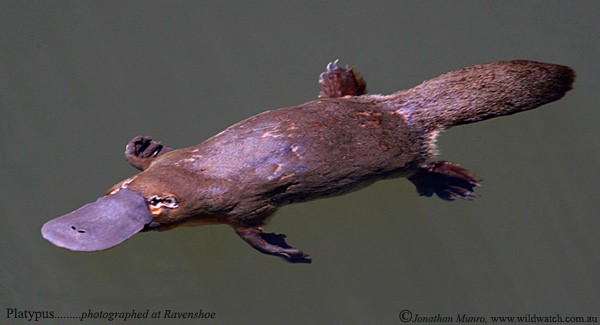The Peculiar Platypus is no stranger to the Wet Tropics…

Photo Credit: http://wildmelbourne.org/articles/2013/11/5/platypus-magic
One of the most peculiar and definitely the strangest of animals found in the Wet Tropics would easily have to be the platypus. From its first discovery there has been much controversy surrounding them, for they are a venomous mammal that lays eggs, has a duck bill, the tail of a beaver, webbed feet and claws for digging. In fact, from their first discovery in the late 1700’s they were thought to be a hoax. When the first specimens were sent back to Great Britain they were dissected to see if they were real. The naturalists of the time believed the first specimen to be parts of different animals sewn together and judged it a fake. It was not until the third specimen arrived that the experts believed it could be real and not a practical joke. There is even an Indigenous dreamtime story which explains the platypus as being born a hybrid, a mix between a duck and a water rat.
The Peculiar Platypus is no stranger to the Wet Tropics…
As you will have realised by learning about Australian Fauna, they are wildly different from animals around the rest of the globe. Evolution worked its magic down under and come up with some amazing variants. The platypus is the perfect example of this and deserves some extra attention to understand its eclectic array of adaptions.
Living in burrows alongside river systems down the east coast of Australia this creature is truly fascinating, and the best way to understand it is to study some of its adaptive features. This will also help explain why the first naturalists thought its discovery a joke.
The Platypus is an egg laying mammal, otherwise known as a monotreme. Alongside the echidna, there are no other mammals known to lay eggs. Scientists believe that in the past, prior to delivering their young, mammals may have laid eggs, thus making the platypus a relic of the animal kingdom. The female will return to her burrow to lay the small eggs which take about 10 days to hatch. To help incubate the eggs, the fatty tail of the mother hugs them close to her body. This maintains the perfect temperature for the eggs to hatch. The little puggles will then nurse from the fur on the mothers stomach as she has no nipples.
Thats just the start of the strange for these questionable creatures. As mammals they breathe oxygen, but they also spend a lot of time in the water as they feed on insects, lava, shrimp and other tiny animals in the water. Once they dive under the water, folds of skin are used to cover their eyes and ears, and they also seal their noses shut. This limits hunting times to about 30 to 60 seconds under the water. As they have adapted to hunting without sight, they use electroreceptors in their bills to detect their prey. Thats right, their bill will find other creatures by sensing the electrical signals emanating when their prey moves. It is one of the few mammals able to feed without using the senses of sight or smell. Also as the platypus has no teeth and uses its flat bill to grind any food it finds.
Looks can be deceiving for this docile little monotreme. A male platypus is believed to be one of the most venomous creatures in Australia. Whilst appearing small and helpless, this little creature has dangerous ankle spurs that excrete a defensive venom. If the male feels threatened, he can use these to incapacitate or kill any threats. Their venom is definitely fatal to a dog, but if a human was spiked by one of these spurs it would not be fatal. The resultant injury to humans is described as excruciatingly painful and has known leave sensitivity for months.
This cute and timid little creature, or so what appears to be, has survived throughout history with ingenious adaptive mechanisms. Platypus are semi aquatic creatures that thrive in fresh water which is generally extremely cold. To be able to keep warm is quite a feat in these conditions. It’s body and tail are covered in an extremely thick waterproof fur to keep them warm. With about 800 hairs per square inch on their bodies, this fur creates a small pocket of air for insulation next to the skin.
The platypus is just as elusive as it is interesting, if people are interested in trying to spot one on our day tour there are some great spots, but it is definitely a game in patience to spot them. Peterson’s Creek near Yungaburrah is a great place to try. Remember, when trying to spot the platypus, look for their burrows along the side of the creek, and if bubbles start coming from under the water, follow them hopefully a platypus will emerge soon. The easiest time to spot them is when they are feeding as they come to the surface to breath and also to grind their food with their bills.
Good luck finding one, it is worth it.
